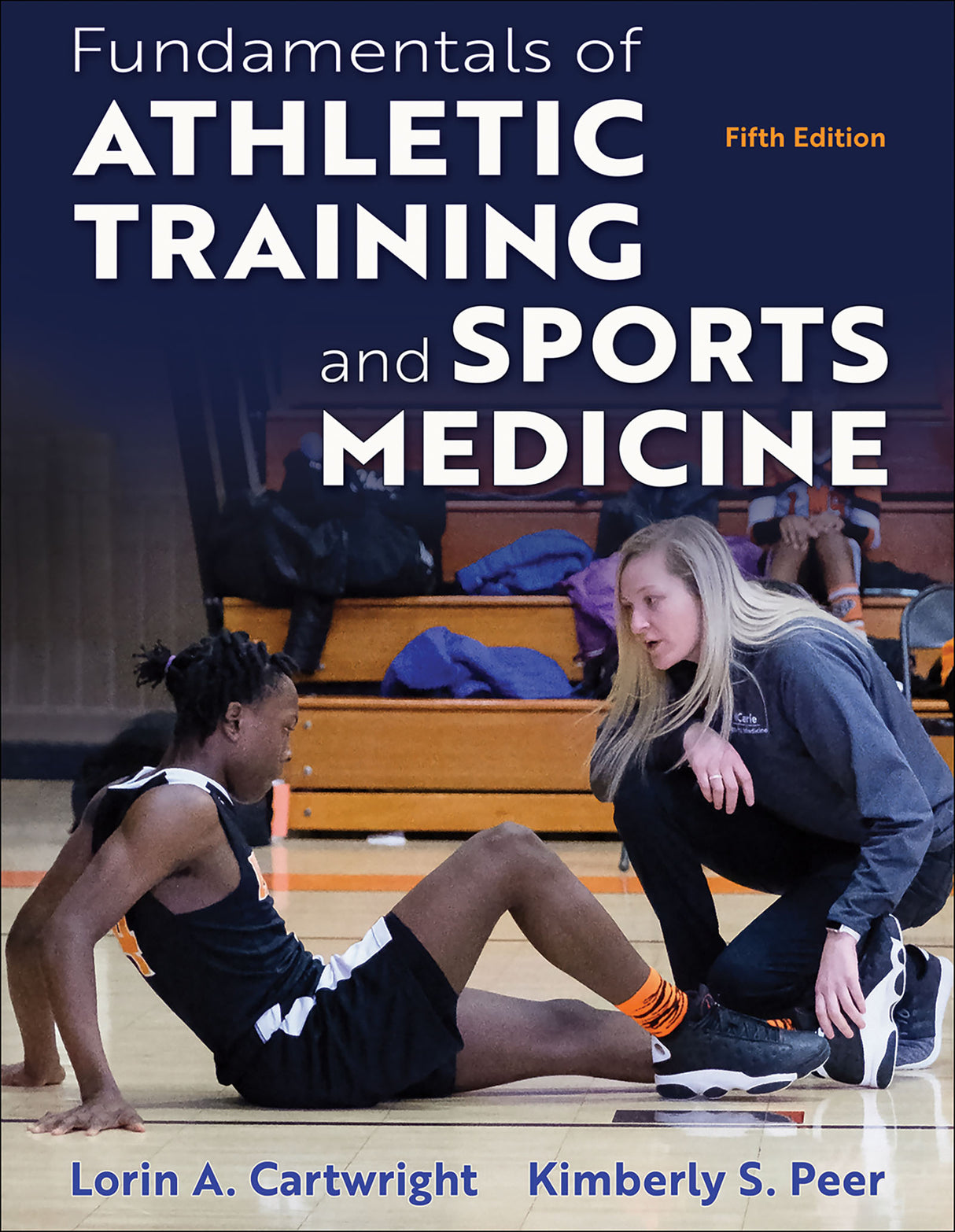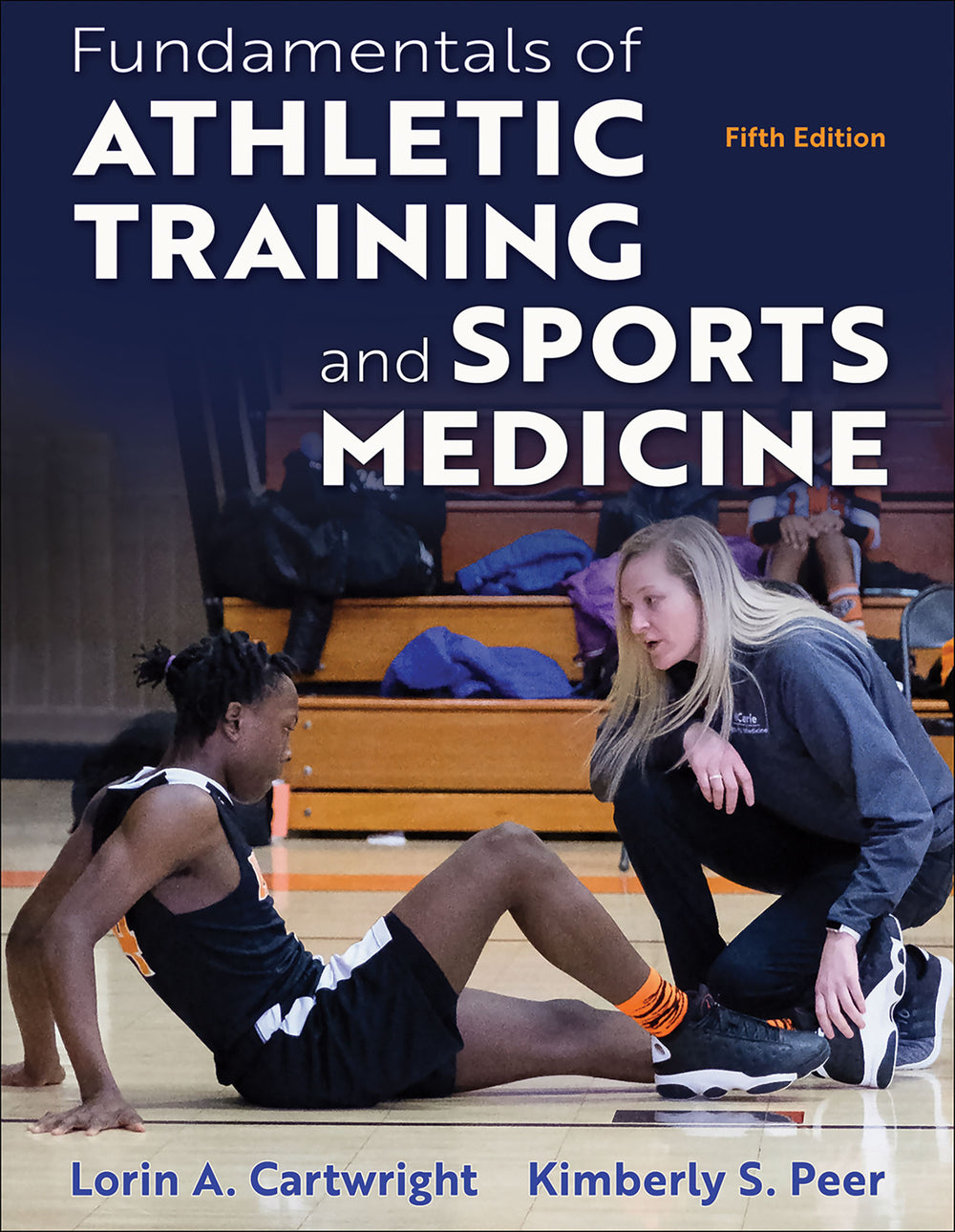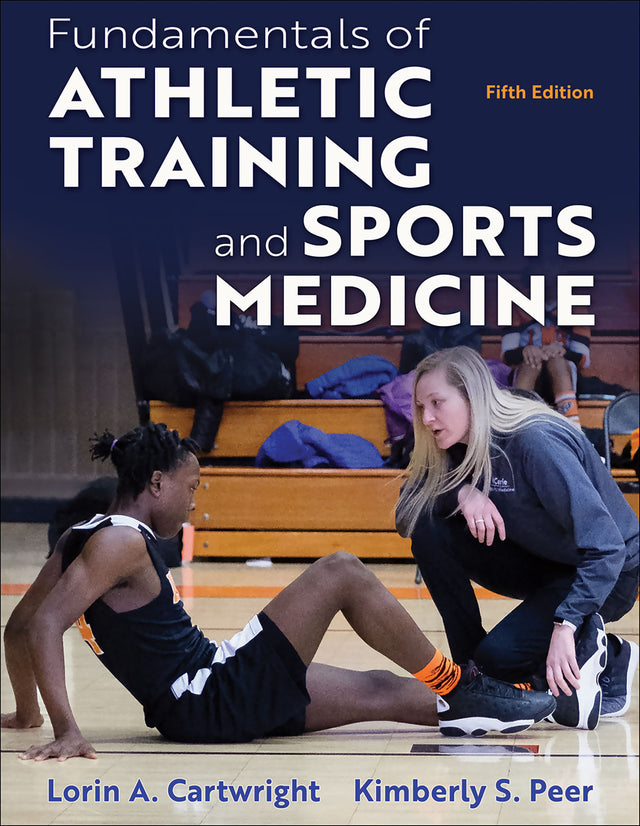Authors: Lorin A. Cartwright and Kimberly Peer
This textbook offers a well-rounded introduction to the fields of sports medicine and athletic training. In an engaging full-color layout, it addresses common injuries and illnesses often encountered in the field, and it explains the professional and administrative aspects of being an athletic trainer or sports medicine specialist. Fundamentals of Athletic Training and Sports Medicine, Fifth Edition With Web Resource, provides students with foundational knowledge and skills as well as the opportunity to explore the possibility of sports medicine as a career.
Topics covered in this text correspond to the National Athletic Trainers’ Association’s secondary-level sports medicine course description. While each unit in the text can stand alone, the topics are progressive in nature. Students will first obtain a knowledge of human anatomy and the physiology of injury and tissue healing before learning about various types of injuries, conditions, and illnesses. The text then addresses the fundamentals of rehabilitation, injury prevention, and return-to-play criteria, including psychological aspects.
The fifth edition covers the latest developments in athletic training regarding treatment, care, and prevention of injuries; administration; and certification. Updated and expanded content includes information on head injury diagnosis and management, new treatment modalities, new taping techniques, and the effects of therapeutic, recreational, and performance-enhancing drug use.
Other learning-friendly features in this edition include the following:
- Red Flags, which warn of potentially hazardous situations
- What Would You Do If . . . features, which present students with complex scenarios to test their decision making in life-threatening situations
- The Real World features, which share actual experiences from practicing sports medicine professionals
- A robust teacher guide with activities, assignments, and tests to support classroom instruction
- A student web resource with 28 step-by-step worksheets for performing specific tasks, activities that provide hands-on experience, and a semester-long project for building practical skills
Authors Cartwright and Peer provide comprehensive coverage of topics in 35 chapters, organized into nine units; a glossary; an index; and an exhaustive list of updated references that attests to the authoritativeness of the information provided. Fundamentals of Athletic Training and Sports Medicine, Fifth Edition, is a thorough guide for students to understand the scope of the role as well as the skills and expertise necessary to embark on the path to a career in sports medicine.
List of Anatomical Drawings
Unit I. Introduction to Sports Medicine and Athletic Training
Chapter 1. Athletic Training as a Profession
Roles of the Athletic Trainer
The Sports Medicine Team
Becoming a Certified Athletic Trainer
Athletic Training Careers
National Athletic Trainers’ Association
Life–Work Balance
Summary
Chapter 2. Administration and Professional Development
Legal Issues
Avoiding Legal Problems
Insurance
Professional Development and Continuing Education
Summary
Chapter 3. Design and Development of the Athletic Training Facility
Facility Design and Development
Safety Factors and Planning Issues
Maintenance of Facility and Modalities
Material Safety Data Sheets
Facility Rules
Summary
Chapter 4. Documentation and Record Keeping
Medical Terminology Basics
Medical Documentation Notes
Documentation and Record Keeping
Patient Confidentiality
Summary
Chapter 5. Fiscal Management
Types of Budgets
Designing a Budget
Purchasing
Inventory Management
Insurance and Reimbursement
Summary
Chapter 6. The Preparticipation Physical Exam
Preparticipation Format and Parts
Medical Information Forms
Clearance for Participation in Sport
Summary
Unit II. Basics of Human Anatomy and Physiology
Chapter 7. Introduction to Anatomy
Anatomical Position
Body Tissues
Classification of Joints
Muscle Movement
Summary
Chapter 8. Basics of Tissue Injuries
Soft-Tissue Injuries
Bone Injuries
Diagnostic Testing for Soft-Tissue and Bone Injuries
Summary
Unit III. Athletic-Related Injuries to the Head, Spine, and Axial Region
Chapter 9. Head Injuries
Anatomy of the Head
Preventing Head Injuries
Head Injury Mechanisms
Treating Head Injuries
Summary
Chapter 10. Facial Injuries
Anatomy of the Facial Region
Preventing Facial Injuries
Treating Eye Injuries and Conditions
Treating Ear Injuries
Treating Nose Injuries
Treating Mouth Injuries
Summary
Chapter 11. Throat and Thorax Injuries
Anatomy of the Throat
Anatomy of the Thorax
Preventing Throat and Thorax Injuries
Treating Throat Injuries and Conditions
Treating Thorax Injuries and Conditions
Summary
Chapter 12. Abdominal Injuries
Anatomy of the Abdomen
Preventing Abdominal Injuries
Treating Abdominal Injuries and Conditions
Summary
Chapter 13. Genitourinary and Gynecological Injuries and Conditions
Genitourinary Anatomy
Injuries and Conditions to the Female Reproductive Systems
Injuries and Conditions to the Male Reproductive Systems
Sexually Transmitted Infections
Summary
Chapter 14. Spinal Injuries
Anatomy of the Spine
Postural Considerations
Preventing Spinal Injuries
Treating Lumbar Spine Injuries and Conditions
Treating Cervical Spine Injuries and Conditions
Summary
Unit IV. Athletic-Related Injuries to the Upper Extremity
Chapter 15. Shoulder Injuries
Anatomy of the Shoulder
Preventing Shoulder Injuries
Treating Shoulder Injuries
Muscle, Bursa, and Tendon Injuries
Ligament and Joint Injuries
Summary
Chapter 16. Elbow Injuries
Anatomy of the Elbow
Preventing Elbow Injuries
Treating Elbow Injuries and Conditions
Summary
Chapter 17. Wrist and Hand Injuries
Anatomy of the Wrist and Hand
Preventing Wrist and Hand Injuries
Treating Wrist and Hand Injuries and Conditions
Summary
Unit V. Athletic-Related Injuries to the Lower Extremity
Chapter 18. Hip, Pelvis, and Thigh Injuries
Anatomy of the Hip, Pelvis, and Thigh
Preventing Hip, Pelvis, and Thigh Injuries
Treating Hip, Pelvis, and Thigh Injuries and Conditions
Summary
Chapter 19. Knee Injuries
Anatomy of the Knee
Preventing Knee Injuries
Treating Knee Injuries and Conditions
Summary
Chapter 20. Foot, Ankle, and Lower-Leg Injuries
Anatomy of the Foot, Ankle, and Lower Leg
Preventing Foot, Ankle, and Lower-Leg Injuries
Treating Foot, Ankle, and Lower-Leg Injuries and Conditions
Summary
Unit VI. Rehabilitation and Reconditioning of Athletic Injuries
Chapter 21. Patient Assessment and Treatment Methods
Assessing the Athlete and Documenting the Findings
Phases of Treatment
Therapeutic Modalities
Summary
Chapter 22. Reconditioning Programs
Strength and Conditioning Principles
Types of Muscle Actions
Muscular Development Programs
Stretching to Improve Joint Flexibility
Exercises for Reconditioning Muscles
Cardiorespiratory Conditioning
Neurological Reconditioning
A Word on Safety
Summary
Chapter 23. Psychosocial Aspects of Athletic Training
Mental Health Risk Indicators
Referring an Athlete for Professional Help
Relationship Building
Practical Suggestions
Summary
Unit VII. Providing Emergency Care
Chapter 24. Planning for Emergencies
Medical Emergency Cards
The Emergency Action Plan
Practicing the Emergency Action Plan
Pandemic Management Plan
Summary
Chapter 25. Primary and Secondary Emergency Procedures
Primary Assessment
Breathing Emergencies
Cardiopulmonary Emergencies
Hemorrhage
Preventing Communicable Disease Transmission
Secondary Assessment
HIT
Specific Conditions
PRICES Method
Summary
Chapter 26. Environmental Situations and Injuries
Heat-Related Problems
Cold-Related Problems
Severe Weather
Bites and Stings
Summary
Chapter 27. Stabilization and Transportation of Injured Athletes
Equipment Removal
Lifting and Moving an Athlete
Summary
Unit VIII. Injury Prevention and Diagnostic Testing
Chapter 28. Protective Taping, Wrapping, Bandaging, and Casting
Principles of Taping
Taping Techniques
Elastic Wrapping Techniques
Bandages and Their Use
Casting
Summary
Chapter 29. Protective Equipment and Durable Medical Equipment Used in Athletics
Protective Equipment for the Head and Face
Protective Equipment for the Upper Body
Protective Equipment for the Lower Body
Durable Medical Equipment
Summary
Chapter 30. Basic Diagnostic Imaging and Testing
X-Rays
Bone Scans
CT Scans
MRI
Ultrasound
DEXA Scans
PET Scans
Blood Testing
Summary
Unit IX. Other Athletic Conditions and Concerns
Chapter 31. Systemic Conditions
Respiratory Conditions
Vascular Conditions
Lymphatic Conditions
Immune System Conditions
Gastrointestinal Conditions
Diabetes
Epilepsy
Arthritis
Thyroid Disorders
Female Athlete Triad
Rhabdomyolysis
Summary
Chapter 32. Communicable Conditions and Dermatological Conditions
Defending Against Microorganisms
Dermatological Conditions
Blood-Borne Conditions
Summary
Chapter 33. Common Drugs Used in Athletics
Drug Administration
Drug Approval Process
Therapeutic Drug Effects
Purchasing Therapeutic Drugs
Therapeutic Drugs
Recreational Drugs
Performance-Enhancing Drugs
Drug Testing
Over-the-Counter (OTC) Drugs
Drug Abuse
Safety in Distribution of Medications
Proper Disposal of Medications
Summary
Chapter 34. Nutrition and Weight Management
Major Nutrients
Healthy Diet
Understanding Food Nutrition Labels
Caloric Balance
Sport Nutrition
Popular Diets/Fads
Popular Nutritional Supplements
Summary
Chapter 35. Special Populations
History of Disabled Sport
Musculoskeletal Conditions
Auditory and Visual Impairments
Cardiovascular Disorders
Transplants
Neuromuscular Disorders
Cognitive Conditions
Female Conditions
Assessing Participation Conditions
Common Injuries
Summary
Lorin A. Cartwright, MS, ATC, has extensive experience in all aspects of instruction of student athletic trainers. She was the first woman to graduate from Grand Valley State University with a degree in athletic training, and she went on to earn a master’s degree in education from the University of Michigan. She was the head athletic trainer, assistant principal, and athletic director at Pioneer High School in Ann Arbor, Michigan, where she served for more than 32 years. She was an adjunct professor in athletic training at the University of Michigan for three years and also taught at Eastern Michigan University and Concordia University.
Cartwright was also the first woman to serve as president of the Great Lakes Athletic Trainers Association (GLATA). She was appointed by the governor of Michigan to the Michigan Board of Athletic Trainers and the state’s Task Force on Women in Sports. She has been an active member of the National Athletic Trainers’ Association (NATA) LGBTQ+ Advisory Committee, recent cochair of the Michigan Athletic Trainers' Society Diversity, Equity, and Inclusion Committee, and is currently working on the NATA Honors and Awards Committee.
Highly regarded in her field, Cartwright received NATA’s Gail Weldon Award of Excellence in 2022. She was also the recipient of NATA’s Most Distinguished Athletic Trainer Award in 2018, GLATA’s Golden Pinnacle Award in 2016, and GLATA’s Outstanding Educator Award in 2010. She has been inducted into the Ann Arbor Pioneer High School Hall of Fame, the Michigan Athletic Trainers' Society Hall of Fame, the Great Lakes Athletic Trainers Association Hall of Fame, and the National Athletic Trainers’ Association Hall of Fame.
Kimberly S. Peer, EdD, ATC, FNATA, FNAP, is a full professor in the athletic training department at Kent State University in Kent, Ohio. She holds a doctorate in higher education administration with a cognate in health care management from the University of Akron. She teaches in the areas of professional development, ethics for health care providers, education and supervision, and scientific writing. Before coming to Kent State University, Peer was on the faculty of University of Mount Union (formerly Mount Union College) and served as the director of the Academy for Health and Sport Science and as coordinator for sports medicine at the Rehabilitation and Health Center. Prior to beginning her clinical and academic positions, Peer received her master’s degree in athletic training from Western Michigan University and her bachelor’s degree from Kent State University.
In addition to having served as the editor in chief for the Athletic Training Education Journal, Peer serves on the National Athletic Trainers’ Association (NATA) Executive Council for Education and the NATA Committee on Professional Ethics. She also serves on the Board of Certification (BOC) Standards Committee. Her statewide service includes the governor’s appointment to the Ohio licensure board and over 12 years of leadership service, including as president of the Ohio Athletic Trainers’ Association (OATA).
Peer is a fellow of the NATA and a distinguished scholar fellow of the National Academies of Practice (NAP). She is a member of the NATA Hall of Fame (2024 class), was awarded NATA’s Gail Weldon Award of Excellence in 2023, and received NATA’s Most Distinguished Athletic Trainer Award. In addition, she was inducted into the OATA Hall of Fame in 2012 and earned the Dan Libera Service Award from the BOC in 2014. She has also been lauded with other national, regional, and state-level awards for her contributions to the profession and to athletic training education, including NATA’s Sayers “Bud” Miller Distinguished Educator Award, GLATA’s Outstanding Educator Award, and OATA’s Linda Weber Daniel Outstanding Mentor Award. She has published and presented extensively on ethics education and pedagogy, and she has coauthored textbooks on professional ethics and fundamentals in athletic training.
All you need to easily implement Fundamentals of Athletic Training and Sports Medicine, Fifth Edition!
Teacher guide. Includes a sample class syllabus, tips for running practical lessons, and chapter-specific files that contain chapter objectives, key points, lecture outlines, and resource lists. Supplemental learning activities include extra-credit assignments, instructions for an index card anatomy project, a crisis plan assignment, and a lesson on measuring range of motion. Instructors will also find guidelines for presentations and term papers, a lesson plan analysis form, a course evaluation form, answers to the student worksheets from the web resource, and answers to the What Would You Do If . . . scenarios found within the textbook.
Test package. Includes more than 600 multiple-choice questions, organized by chapter. The files may be downloaded or printed for use as paper-based tests.
Chapter quizzes. Contains ready-made quizzes (9-10 questions each) to assess student comprehension of the most important concepts in each chapter. The quizzes may be downloaded or printed for use as paper-based tests.
Presentation package. Features more than 600 PowerPoint slides of text, artwork, and tables from the book that can be used for class discussion and presentation. The slides in the presentation package can be used directly within PowerPoint or printed to make handouts for students. Instructors can easily add, modify, and rearrange the order of the slides.
Image bank. Includes most of the figures, content photos, and tables from the text, sorted by chapter. These can be used in developing a customized presentation based on specific course requirements.
Instructors also receive access to all student materials. For Fundamentals of Athletic Training and Sports Medicine, Fifth Edition, this includes 28 step-by-step skills worksheets for performing specific tasks, activities that allow for hands-on experience, and a semester-long project that develops with each chapter to give students a true understanding of the requirements needed to be an effective athletic trainer.
All Teacher Pack Tools are available through HKPropel, a digital content delivery and learning platform. It can be integrated with any learning management system that supports Learning Tools Interoperability (LTI) 1.3 and provides LTI Advantage services such as Assignment and Grade Services and Deep Linking.
View the full list of ISBNs and the various product bundles.
Connect with us.
Contact our K-12 Sales Department to discuss how Fundamentals of Athletic Training and Sports Medicine, Fifth Edition, can be configured to meet the needs of your community.
Phone: 855-473-7345 or
Email: K12sales@hkusa.com









